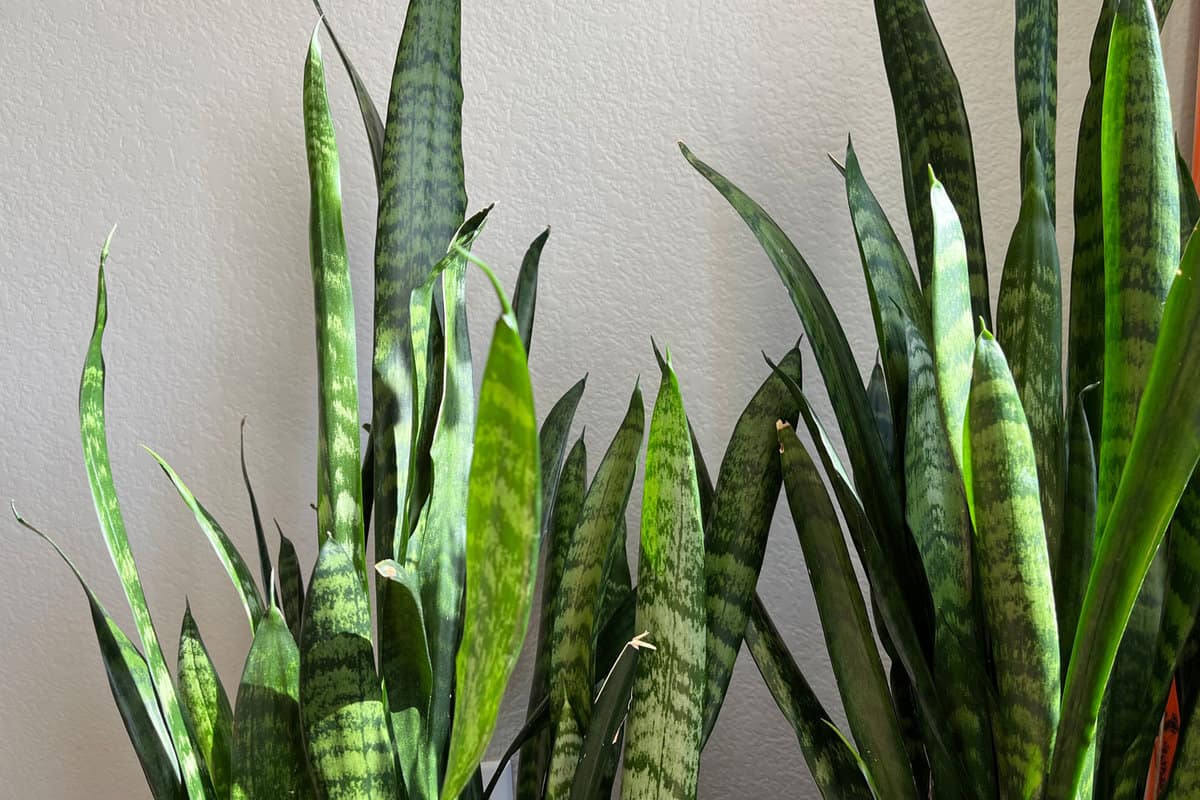Snake plants, also known as Sansevieria or Mother-in-Law's Tongue, are popular houseplants known for their hardiness and low maintenance requirements.
However, one issue that some snake plant owners may encounter is their plant growing too tall. This can result in an unstable plant that lacks the root support it needs, causing it to lean or even fall over.

A too-tall snake plant may also become less aesthetically appealing as it grows out of proportion.
To keep your snake plant healthy and visually pleasing, it is important to understand and manage its growth effectively.
Proper care, including appropriate lighting, watering, and fertilizing, can prevent excessive growth in snake plants.
By identifying the factors contributing to your plant's rapid height increase, you can take the necessary steps to maintain its ideal size and shape.
Understanding Rapid Growth
One of the main challenges associated with snake plants is their tendency to grow too tall, especially when they are not receiving enough sunlight.

Insufficient sunlight causes the plant to stretch in search of more light, resulting in rapid growth. Overwatering could also contribute to this issue.
To manage the growth of a snake plant:
- Ensure the plant receives sufficient sunlight: Place it in a well-lit area near a window to provide it with enough light for optimal growth.
- Monitor watering: Avoid overwatering, as this can also cause rapid growth and other problems such as root rot.
- Support the plant: If the plant still grows too tall, consider using a support stake or tying the leaves together to keep the plant upright.
With proper care, your snake plant can thrive and become a beautiful addition to your indoor garden.
Immediate Height Reduction for Overgrown Snake Plants
In cases where your snake plant has grown excessively tall and is in immediate need of height reduction, following a deliberate procedure is essential to ensure the health and aesthetic appeal of the plant.
Here’s how to go about reducing the height of an overgrown snake plant:
1. Evaluate and Prepare
Evaluate the health of the plant and identify the sections that have grown out of proportion.
Ensure you have sharp, clean pruning shears or scissors to prevent infection and ensure a clean cut.
2. Pruning
Identify the leaves that are excessively tall. Cut the tall leaves back to the desired height, making a straight or angled cut across the leaf.
It's advisable to prune no more than one-third of the plant at a time to avoid shocking the plant.
Remove any unhealthy or yellowing leaves at the base to encourage new growth.
3. Adjust Care Practices
Re-evaluate your care routine to prevent future overgrowth. Ensure your snake plant is receiving the right amount of sunlight, water, and fertilizer.
Adhering to these steps will help manage the height of your snake plant and contribute to maintaining a healthy, visually pleasing indoor plant.
Growth Management
Dealing with your snake plant's growth is an ongoing process. Over time, it's important to regularly monitor and care for your plant to ensure it continues to thrive and maintain its health and appearance.
By following these growth management practices, you can better maintain a healthy, attractive, and well-controlled snake plant in your home or office.
Pruning Practices
Pruning is a vital practice for maintaining a healthy and aesthetically pleasing snake plant.
Regularly inspect the plant for dead, dying, or unhealthy leaves that can be removed.
Gently trim them off at the base, ensuring that you do not damage the healthy sections of the plant.
By doing this, you will promote the growth of new, healthy leaves and prevent the plant from becoming too tall or leggy.
Repotting A Snake Plant
As your snake plant continues to grow, it may become necessary to repot it in order to give the roots enough space to grow and thrive.
Choose a pot that is a couple of inches larger in diameter than the current one, ensuring it has adequate drainage holes.
Carefully remove the plant from its old pot, gently untangling roots if needed.
Fill the new pot with fresh, well-draining soil and position the plant in the center, ensuring the leaves sit just above the soil line.
Water it thoroughly, allowing excess water to drain out before placing it back in its growing area.
This may not reduce the height but will provide the roots with more room to grow, promoting overall health and potentially preventing further disproportionate growth.
Note: Typically, a snake plant requires repotting every 4 to 10 years.
However, if the plant facilitates faster growth, the repotting frequency may increase to every 2 to 6 years.
Dealing with Overgrowth
In some cases, your snake plant may still grow too tall despite diligent pruning and repotting. There are several ways to address overgrowth in your snake plant:
- Support stakes: Use a support stake or tie the leaves together to provide stability if your snake plant is becoming top-heavy or unstable.
- Propagation: When the growing season (May to September) arrives, you can consider propagating your plant through leaf cuttings. This not only helps with overgrowth but also allows you to have more snake plants in your collection.
- Avoid over-fertilizing: Excessive growth in snake plants can sometimes be attributed to over-fertilization. To prevent this, be cautious about the amount and frequency of fertilizing your plant.
Proper Plant Management
By following these tips and guidelines, you can effectively manage the growth of your snake plant, ensuring a healthy and beautiful addition to your indoor garden.
Watering Techniques
Proper watering is crucial for maintaining the health of your snake plant.
Overwatering can lead to root rot and eventually, an unstable and unhealthy plant. Underwatering, on the other hand, can lead to slow growth and yellowing leaves.
To ensure adequate hydration, water your snake plant every 10–14 days, allowing the soil to dry out between waterings.
You can use the "soak and dry" method, which involves thoroughly soaking the soil and then letting it dry completely before watering again.
To learn more, check out this article: How Often To Water Your Snake Plant
Optimal Sunlight Exposure
Snake plants thrive in bright, indirect sunlight. While they can tolerate low light conditions, insufficient light may cause the plant to grow too tall as it stretches toward a light source.
Position your snake plant near a window with filtered light or use artificial lighting if necessary.
Rotate the plant every few weeks to ensure even growth and avoid placing it in direct sunlight, which can scorch its leaves.
Importance of Proper Soil
Choosing the right soil for your snake plant plays a significant role in managing its growth.
Snake plants prefer well-draining soil that allows water to pass through quickly, preventing root rot.
A mix of potting soil, perlite, and coarse sand is an ideal choice for these plants.
Additionally, you can use a commercial cactus and succulent mix for convenience.
You might also like to read: What’s The Best Soil For Snake Plants?
Final Thoughts
Caring for a snake plant can be a rewarding experience for any indoor gardener. However, managing its growth can sometimes be a challenge.
By being mindful of the factors that contribute to the plant's excessive growth and implementing proper preventive measures, you can maintain a healthy and beautifully contained snake plant.
Proper lighting conditions are crucial in regulating your snake plant's growth.
Remember that while snake plants can tolerate low light, providing them with bright, indirect light from a north or east-facing window will encourage a balanced growth pattern.
Overwatering and over-fertilizing can also lead to excessive growth in snake plants.
Be keen on how often you water and fertilize your plant to avoid causing your snake plant to grow too tall.
In addition, take time to carry out occasional maintenance by pruning overgrown leaves and rotating your plant regularly to allow for even growth in all directions.
By following these practical steps, you can create an environment that promotes a healthy and stable snake plant that adds a touch of natural beauty to your indoor space.

